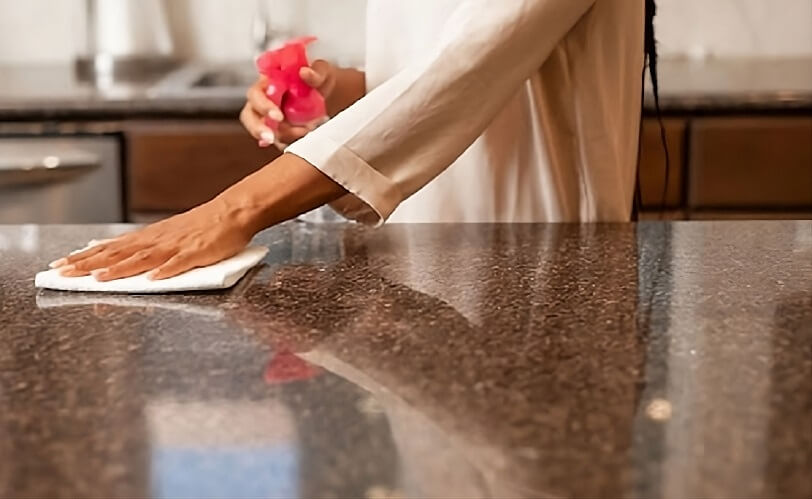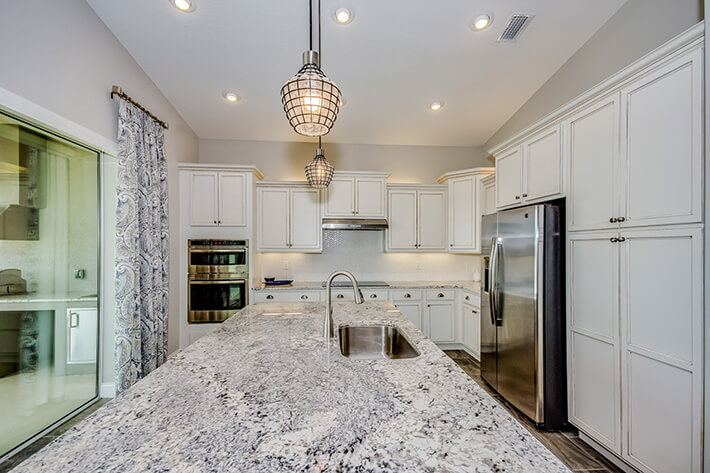Choosing the right countertop material for your kitchens and bathrooms is an important decision. It will affect the functionality of the most used spaces in your home for years to come. As there are many materials to choose from, making the decision can be hard, leaving you unsure whether you are picking the right one.
Keep reading for a deep dive into the marble vs. granite countertops debate and learn about two of the most popular countertops materials so you can make an informed choice about your home. Examining the differences, similarities, and advantages of these materials will be the best tool in your arsenal.
An Introduction to Marble and Granite
Marble is a metamorphic stone. In other words, it is formed through intense heat and pressure within the crust of the earth. Metamorphic rocks form through the reformation of other stones. In the case of marble, limestone. Through the grueling circumstances limestone goes through, it becomes denser and stronger. Moreover, other minerals can get mixed into limestone during the creation process of marble. These added minerals create the vein patterns we know and love today.
On the other hand, granite is an igneous rock. Igneous rocks form through the cooling process of magma. As opposed to marble, which consists mostly of the same material, granite is a combination of different ingredients such as feldspar, quartz, and mica. All of these different minerals give granite their own unique benefits, making it an incredibly hard and durable material that is ideal for high-traffic areas such as kitchen countertops.
Appearance and Aesthetics

When it comes to beauty and elegance, nothing can match marble. Marble countertops are the equivalent of timeless grace. They effortlessly create a sophisticated look in any space they are installed in, bringing a luxurious appearance.
The smooth base of marble countertops is most commonly in shades of light gray, cream, or white. Marble has a unique transparent-like quality that makes it appear like it is glowing from within. This is also the reason why it has been the preferred material of master sculptures for centuries.
Granite has a very versatile beauty that allows it to be utilized in many different areas for various purposes. It is available in a wide variety of colors, ranging from earth tones to vibrant blues and greens. The mica found in the granite gives it a slight sparkle, making it the focal point of the kitchen. Granite also comes in several different finishes such as polished, leathered, and honed, enhancing its versatility.
Durability and Longevity
When it comes to durability between marble vs. granite countertops, granite has the upper hand as it is one of the hardest and strongest materials used in home improvement projects. This is an important factor to consider for the longevity of the countertops and the durability of your project.
Compared to other natural stones such as granite and quartzite, marble is considered to be a soft stone. It has a 3 in the Mohs Scale of hardness, making it more malleable and easier to work with. This softness might seem scary, however, as long as they are properly taken care of, marble countertops can last you a lifetime. Moreover, ornate details and edge profiles that might not be achievable with other stones are possible with marble.
Granite is a very hard, strong, and dense material. It has a score that ranges between 6 to 7 in the Mohs Scale of hardness. It is extremely resistant to chips, cracks, and scratches. It is an amazing choice for kitchen countertops as it will weather daily wear and tear without effort.
Maintenance and Care

Marble countertops require some diligence for their maintenance and they need more attention compared to granite. One of the first things to know when it comes to marble maintenance is to avoid acids and liquids such as lemon juice or vinegar as these can cause the marble to etch.
With both marble and granite, you should avoid harsh chemical cleaners and abrasive tools. Avoid cleaners such as bleach as it can interact with the natural composition of the stone, causing irreversible changes to the stone. Similarly, don’t use abrasives like steel wool because it can result in scratching the surface.
Both granite and marble are natural stones. Therefore, they have a porous structure that could allow dirt, moisture, and bacteria to get trapped inside and grow. To combat this, marble and granite need to be sealed before they are ready for use and they need to be resealed at least annually.
Cost Comparison
Budget is one of the biggest determiners of the material you are going to choose and the decision between marble vs. granite countertops is no different. Both options can vary in price as there are different types, qualities, and rarities to both of them.
Marble has a luxurious and up-scale reputation that makes it more costly in general. The price will go even higher if you are considering very high-quality variations such as Carrara marble. Other factors that might increase the price include the thickness of the slab. Thicker countertops will be more durable and they will have a more substantial appearance.
Granite tends to be more affordable than marble in general. However, similar to marble, high-quality types will have a higher price tag. Rare granite types such as pure white or extremely vibrant colors that are harder to come by will be more expensive. Additionally, imported slabs can cost a lot more than local ones.
Suitability for Different Spaces
The specific needs of your house will help you choose between marble vs. granite countertops. Both of these stones shine in different areas of the home.
For kitchens both marble and granite are popular choices. The decision between the two depends on how heavily the countertops in your kitchen are going to be used and for what purpose. For rigorous daily cooking, granite is the preferred option. However, the properties of marble that allow it to always be cool to the touch make it the favorite of bakers as they commonly work with ingredients such as butter and chocolate.
Outdoor kitchens need to be very durable against weather conditions. Therefore granite countertops are more suitable for this purpose. On the other hand, bathroom countertops and vanity tops are lightly used areas that will radiate with the addition of marble.
Marble vs Granite Installation

Countertop installation involves a lot of planning, measuring, and careful consideration. Both marble and granite are great options that will add a lot of functionality and elegance to the space. Although the installation process for marble and granite share some common steps, certain differences need to be understood and adhered to for a successful project.
Marble is a softer stone compared to granite. This softness means that marble slabs need to be handled with more care and attention during and before the installation. The best course of action is to carry the marble slabs with multiple people to ensure that it is easier to maneuver and the slab won’t slip or bang against hard surfaces as this can cause chipping on the marble.
Cutting marble requires special tools that will help reduce the risk of cracks. After the slab is cut to size and sealed to ensure it is resistant to stains and bacteria, it is dry-fitted on the cabinets to ensure it fits. Adjustments may need to be made if any part of the stone isn’t perfect.
Granite is harder and denser. Therefore it is more resistant to scratches and chips during and after installation. This durability also makes it a popular choice. Similar to marble, the installation of granite starts with a detailed and careful measurement process.
The cutting process of granite slabs is harder and more labor-intensive compared to marble. A diamond saw is required to cut granite because of its hardness. After it is cut and dry-fitted, high-quality silicone or epoxy is used to adhere the granite slab to the cabinets.
Marble vs Granite Customization
When it comes to customizing your countertops, both marble and granite offer a wide range of options. They can fit in with a variety of design styles and preferences. With that being said, each of these materials has qualities that influence how much and in what areas they can be customized.
The softness of marble allows it to be carved into ornate details. Edge profiles such as ogee and bullnose, which may not be possible with harder materials can be achieved thanks to the softness of marble. These ornate details add sophistication and a personalized touch to the countertops.
Moreover, marble can be honed to achieve a matte finish or it can be polished for a glossy finish. Matte countertops add a subtle and organic feeling to the room. They will bring elegance to the room while still letting other design elements shine. Glossy countertops will add brightness and shine to the space they are installed, making them a great addition to rooms that don’t get a lot of natural sunlight.
Although granite offers a variety of edge profiles such as straight or beveled, it is less conducive to ornate detailings than marble. Therefore, if you are set on an edge profile that requires a detailed design, then marble might be the right choice for you.
As granite is more durable than marble, it can be finished in more ways than marble. It can be honed, leathered, flamed, and more to achieve different finishes that will change the overall appearance of the countertops.
In short, both marble and granite are amazing options that will elevate your home regardless of which one you decide to go with. They are gorgeous and durable stones that will elevate the functionality of your home with their longevity. Both options have their pros and cons, what matters is which one delivers on your must-have qualities. This guide will help you understand the differences between granite and marble, thus helping you make the best-informed decision for your and your home’s needs.

